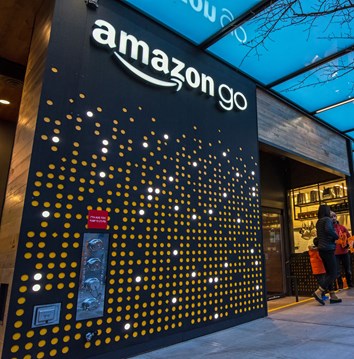
Amazon’s culture of innovation and customer-centric focus
Since its launch in 1994, Amazon has completely changed consumers' shopping experience. Jonno Southam, Senior Business Development Manager at Amazon Web Services, talks to Inflexion's Digital Exchange about customer-centric businesses' need to constantly innovate in order to succeed.
“All of what comes out of AWS stems from people’s innovations in response to customer challenges. We’ve been good at tackling hard problems, effectively reinventing the customer experience over the decades. Think of how your own shopping habits have changed over the years.”
Indeed, online shopping is now a large part of many consumers’ lives, with much of the convenience of today’s web retail influenced by Amazon’s offering, as retailers must remain competitive in order to succeed.
To ensure Amazon remains at the forefront of online retailing, input is encouraged from everyone working there. “To be a good employee, you need to be experimenting all the time, whether to improve the customer experience or productivity. To experiment properly you need to be willing to fail, and then to learn from that failure.”
Jonno explains that this is a top-down approach: “It is crucial to have a vision and be stubborn with it, but flexible on the details of the execution. If you are the CEO and you’re looking to empower your employees to innovate, you need to show this yourself. And the firm – from management through to employees – need to be prepared to be misunderstood.” This, he says, is because the development phase often perplexes onlookers, with most innovation only clear once launched.

Customer first
This innovative culture and approach supports Amazon’s mission of wanting to be “earth’s most customer-centric company”. To facilitate this “customer obsession”, all employees are empowered to be creative and innovate to find ways to make customers’ lives easier. Interestingly, the firm’s mission informs its product development too: rather than create a product and ask marketing to sell it, they start with the customer and work backwards. “We think the product-led approach is the wrong way around and so we try and do what will make customers’ lives easier, even if it’s risky. For example, we included a customer review function when we launched our site. This was completely innovative at the time; other retailers didn’t allow that in case someone wrote something negative about a vendor the retailer was working with. That was vendor-centric; the Amazon model is customer-centric.”
This model is supported by Amazon’s “working-backwards process”. This means the firm considers how to get to the end result, writes the press release to show what it looks like, and shares it round the business and external stakeholders under NDA – all before the product is even developed. The stakeholders give feedback which provides Amazon with conviction it’s something worth pursuing – or the firm leaves the idea and works on something else. “This backward method means we are clear and articulative about what a product can do for customers through a public-facing press release before we develop it. We also include FAQ documents – such as cost of production and benefit to customer.”
As the online shopping experience evolves and retailers vie for custom, consumers demand ever more. “Customers are divinely discontent,” Jonno cautions. “They always want more value, more selection and more convenience. As a company, we need to gain customers’ trust every day. People expect us to have the lowest price. This helps drive customers to the site, which in turn draw third-party sellers wanting to get involved. It’s our growth engine.” He illustrates Amazon’s evolving offering, which increases as the firm grows, with the example of Prime: “When we launched Prime in 2005, it was simply a two-day delivery. Now it offers music, video, pantry, prime now, and more.”

Jonno further spoke on iterating innovation to balance speedy product launches with minimal cost of failure…
Amazon’s iterative innovation and learning from failure
Amazon updates its offering in stages rather than awaiting perfection and incurring the cost and time involved. Jonno Southam, Senior Business Development Manager at Amazon Web Services, talks to Inflexion’s Digital Exchange about iterating innovation to offer customers dynamism.
When Amazon launched its Kindle, it was white and featured a keyboard – a clunky alternative to today’s sleek handheld device. “After that initial launch, we worked to improve it. We launch the most basic item we think people will use and then improve on it.”
This iteration over time allows the firm to go to market quickly with new products and then allow customers to feed back – a sort of crowd testing on a massive scale. While some products may fail, the public’s memory of such failures tends to be weaker than their memories of its successes. For example, few recall Amazon’s Fire smartphone, though many are Prime members and now enjoy Amazon Fresh.
An additional benefit of iterative innovation is the mitigating effect it can have on sunk costs, namely testing. By allowing the ultimate end-consumers to feed back on products, the costly testing phase is reduced. This effectively allows the firm to learn from the feedback without paying for it.
Much of the firm’s innovation is done in “two-pizza teams”, meaning there can be more than one team working to solve the same problem. “We get small teams to totally own a portion of the business – if it goes wrong, they fix it. These teams have autonomy. This single-thread focus enables self-directed teams and fosters ownership and autonomy. The potential downside is that there are lots of tools duplicated throughout Amazon, but we’re prepared to accept it as we feel it’s the right way to innovate on behalf of our customers.”
Prepare to fail, be misunderstood
“We are willing to go down a bunch of dark alleys and occasionally we find something that really works. If you want to be inventive, it is best to fail quickly and cheaply.” Some of the firm’s innovations require time to get going, during which onlookers may ask questions. “Whilst developing Amazon Web Services (AWS), commentators wondered what we were up to delving into cloud computing, but we were prepared to be misunderstood. We understood the cross benefits and need to experiment. We understood that, but nobody else did, and we were comfortable with that.” Ultimately it paid off.
Sometimes successes can come from failures. The aforementioned Fire smartphone saw Amazon sink a sizeable sum into developing the tools to make it work. Rather than bury the project fully, the hardware team was redirected and eventually spawned the Echo. Another failure-turned-success was Amazon’s now defunct auction site. “We launched an auction site to compete with eBay. It failed and was shut down; however, it did allow third parties to sell on our site that ultimately led to Amazon Seller Marketplace. It created competition and keeps prices low. The seller business is now bigger than our own Amazon products, and this came out of that failure. You can always learn something from experimentation and failures!”
Contact


